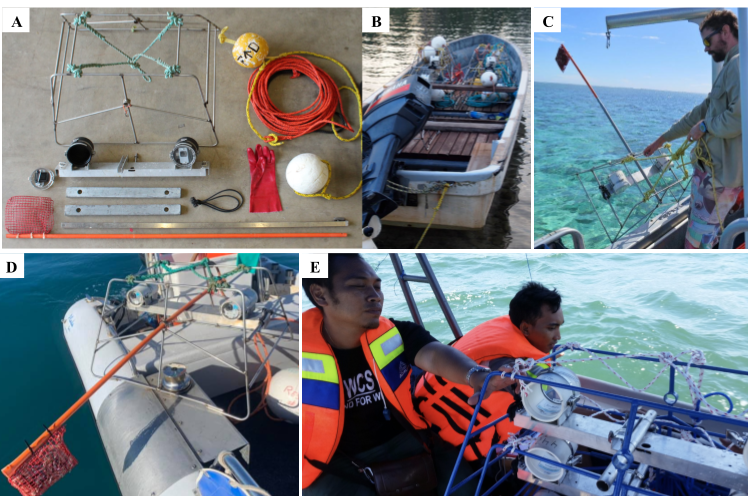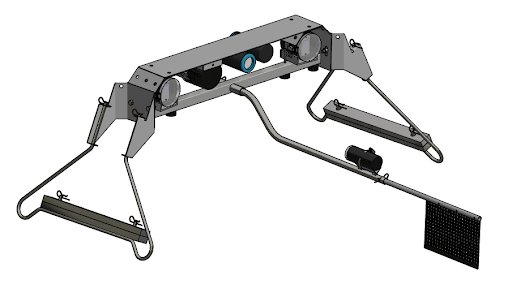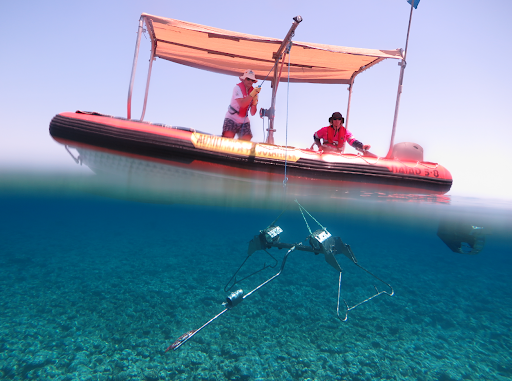Field logistics
Vessels fitted with a swinging davit arm, or pot-tipper and winch are ideal for deploying and retrieving stereo-BRUVs in deeper waters (Figure 1, Figure 2), however, light-weight stereo-BRUVs (Figure 1, Figure 4) can be retrieved by hand. Comparable trap fishing retrieval methods are generally the most efficient. Each retrieval design remains dependent on the type of vessel used, stereo-BRUV weight and size, and prevailing sea conditions. Local fishers familiar with a study location can provide valuable advice on sampling logistics. Multiple stereo-BRUVs can be deployed concurrently, with ~10 stereo-BRUV systems providing optimum logistical efficiency for 60 minute deployment times. Crepuscular periods should be avoided due to demonstrated changes in fish behaviour during these times (Myers et al. 2016; Bond et al. 2018a). When sampling in low light conditions, both blue (450-465 nm) and white (550–560 nm) lights can be used. White can provide the best imagery for identification (Birt et al. 2019), but blue has been found to avoid potential behavioural biases and reduce backscatter from plankton at night (Fitzpatrick, McLean & Harvey 2013). Field methodology checklists are provided below.

Figure 2: Methods to safely deploy and retrieve BRUVs from different size vessels using different equipment. A: deploying a stereo-BRUV using an A-frame and pulley at the vessel’s stern; B: deploying a stereo-BRUV with weights and a light from the side of a vessel; C: deploying light-weight stereo-BRUV from a small rigid inflatable (see Figure 4); D: using a ‘pot winch’ and ‘pot tipper’ to quickly retrieve stereo-BRUVs in deep water; E: retrieving a stereo-BRUV using a davit arm from the side of a vessel; F: retrieving stereo-BRUVs by hand using an repurposed anchor hauler in the Philippines.

Figure 3: Stereo-BRUV systems, including (A) standard dimensions, and (B) addition of weights for deeper water deployment and added forward and rear facing lights and rear facing stills camera to collect habitat imagery.

Figure 4: Light weight stereo-BRUV. (A) Frame made of thin gauge stainless steel. Diode arm is passed through the back and front of the frame and not attached to the base bar. This reduces strain to the base bar during retrieval and allows the base bar to be made of light-weight hollow aluminium rectangular section (D). Base bar uses hooks and bungee cords to attach to the frame. The separation of cameras has been reduced to 500mm, with camera convergence of 5 degrees, to decrease the size of systems and making them easier for (B) travel with and use on smaller vessels and can be (C) hand-hauled. For research projects led by partners without expertise in stereo calibrations, (E) frames can be manufactured locally and pre-calibrated light-weight base bars can be sent to the study site. See this video example of deploying light weight stereo-BRUV.


Figure 5: Stereo-BRUV systems developed by the Australian Institute of Marine Science (AIMS). Designed to be easily assembled and packed down with detachable legs that occupy minimal space when shipping. The cameras are inwardly converged at 5 degrees and separated by 650mm. Camera cradles are precision machined and have a locating pin that aligns with the back of the camera housing which allows for housings to be easily removed from the frame (for battery change, downloading etc.) and put back in the exact same position, maintaining camera calibration. A plate across the top of the frame allows for additional backward facing cameras or lights to be attached. The lack of rails along the front and back of the frame footing reduces potential for seabed snags and minimises contact with seabed habitats.
Packing Checklist
| Gear | |
|---|---|
| Rope | |
| Floats | |
| Frames | |
| Base bars | |
| Bait arms | |
| Bait bags | |
| Weights | |
| Light & backwards camera base bars (if required) | |
| Housings | |
| Bait bin | |
| Tools/consumables | |
| Drill | |
| Impact driver | |
| Socket adaptors | |
| Sockets | |
| Adjustable spanners | |
| Cable ties | |
| Rope gloves | |
| Bait gloves | |
| Spare o-rings | |
| Hose clamps | |
| Tape | |
| Silicone grease | |
| Microfibre cloths | |
| Towels | |
| Pencils/Pens | |
| Clipboard | |
| Whiteboard and markers (for showing cameras metadata) | |
| Shark clips | |
| Bungee cord or nuts and bolts to fasten base bar to frame | |
| Hot knife | |
| Inox | |
| Wire cutters | |
| Bottle of isopropyl alcohol to soak any salt damaged electronics - not batteries | |
| Electronics | |
| Cameras & spares | |
| Camera chargers & spares | |
| Camera batteries & spares | |
| Camera battery chargers & spares | |
| Lights & spares | |
| Light batteries & spares | |
| Light chargers & spares | |
| Magnets (if required to turn on lights) | |
| SD cards | |
| Box for used SD cards | |
| SD card readers | |
| Quick computer to download videos (Laptop or NUC) | |
| Mouse | |
| Keyboard | |
| USB hubs | |
| Hard drives, back-ups & spares | |
| Tablet/Laptop for recording metadata | |
| Paper copies of metadata recording data sheets | |
| GPS | |
| GPS charger | |
| Extension cords | |
| Powerboards | |
| Planned sampling locations formatted for the vessels plotter (on a device the plotter can read e.g. USB drive or SD card) | |
| Paperwork | |
| Animal ethics | |
| Field work risk assessments | |
| Any permits required for undertaking work within Marine Parks etc. | |
| Hard copy sampling map if any locations are pre planned | |
Field Methodology Checklists
Pre-field work
- Check equipment as shown in Figure 1 and Table 1.
- Conduct 3D calibration of stereo-camera pairs. We recommend an enclosed pool environment with good visibility. This must be repeated at the end of the field campaign, or if any camera or housing positions have changed.
- Ensure sampling design can be imported to the research vessel navigation system, or bring a standalone navigation and sounding system for the skipper.
- Ensure sufficient data storage capacity for downloading all video imagery collected, and for back-up copies.
- Ensure sufficient spares for stereo-BRUVs (Figure 1).
- Purchase bait and ensure it can be stored appropriately for the duration of fieldwork.
- Create a metadata sheet or preferably using a capture device (e.g. Collector for ArcGIS or QGIS, tablet computer with GIS) to record the sample, stereo-camera pair and memory card unique identifier in addition to other essential field data (Table 2 and Table 3). By capturing metadata digitally transcription errors and post-field work time are reduced.
Table 2. Suggested columns for the sample metadata. Transposed (rows for columns) for formatting convenience.
| Column name | Format | Column required for GlobalArchive and CheckEM |
|---|---|---|
| opcode | String | ✔ if opcodes were used to define a sample. DON’T include this column if it is not required to define a sample. |
| period | String | ✔ if periods were used to define a sample. DON’T include this column if it is not required to define a sample. |
| latitude_dd | Decimal degrees. Must be between -90 to 90. | ✔ |
| longitude_dd | Decimal degrees. Must be between -180 to 180. | ✔ |
| date_time | YYYY-MM-DDThh:mm:ssTZD YYYY = four-digit year MM = two-digit month (01=January, etc.) DD = two-digit day of month (01 through 31) T being a required literal character. hh = two digits of hour (00 through 23) mm = two digits of minute (00 through 59) ss = two digits of second (00 through 59) TZD = time zone designator (Z or +hh:mm or -hh:mm) |
✔ |
| site | String. The scale of sites are up to the user to define. | ✘ |
| location | String. The scale of locations are up to the user to define. | ✘ |
| status | MPA status (must be Fished, No-take, I, II, III, IV, V, VI) | ✔ |
| depth_m | Floating point number (metres) | ✔ |
| left_cam_number | String. | ✘ |
| right_cam_number | String. | ✘ |
| left_memcard_number | String. | ✘ |
| right_memcard_number | String. | ✘ |
| successful_count | Was the sample annotated for count and will that data be included in any analysis? String ("Yes", "No" or blank). |
✔ |
| successful_length | Was the sample annotated for length and will that data be included in any analysis? String ("Yes, "No" or blank). |
✔ |
| observer_count | String (Full name of analyst). Only required if successful_count = “Yes” |
✔ |
| observer_length | String (Full name of analyst). Only required if successful_length = “Yes” |
✔ |
| visibility_m | Floating point number (metres) | ✘ |
| inclusion_probability | Floating point number. The probability of including that sample in a spatially balanced sampling design. | ✘ |
| observer_habitat_forward | String (Full name of analyst) | ✘ |
| observer_habitat_backward | String (Full name of analyst) | ✘ |
| observer_habitat_downward | String (Full name of analyst) | ✘ |
| successful_habitat_forward | String ("Yes" or "No") | ✘ |
| successful_habitat_backward | String ("Yes" or "No") | ✘ |
| successful_habitat_downward | String ("Yes" or "No") | ✘ |
Table 3. An example of the first five rows of a $_Metadata.csv file. This is an example for a campaign with additional backwards facing cameras for habitat annotation where the sample is defined using the opcode column only.
| opcode | latitude_dd | longitude_dd | date_time | left_cam_number | right_cam_number | left_memcard_number | right_memcard_number | site | location | status | depth_m | successful_count | successful_length | observer_count | observer_length | successful_habitat_forward | successful_habitat_backward | observer_habitat_forward | observer_habitat_backward |
|---|---|---|---|---|---|---|---|---|---|---|---|---|---|---|---|---|---|---|---|
| 35 | -34.1315 | 114.9236 | 2023-03-15T07:36:19+08:00 | L21 | R22 | 01 | 02 | Site 1 | South-west Corner | No-take | 39.6 | Yes | Yes | Hannah Williams | Gidget Mirrabelle | Yes | Yes | Hannah Williams | Hannah Williams |
| 5 | -34.1295 | 114.9292 | 2023-03-15T07:49:41+08:00 | L23 | R24 | 03 | 04 | Site 1 | South-west Corner | No-take | 42.7 | Yes | Yes | Hannah Williams | Gidget Mirrabelle | Yes | Yes | Hannah Williams | Hannah Williams |
| 26 | -34.1272 | 114.9284 | 2023-03-15T07:54:35+08:00 | L25 | R26 | 05 | 06 | Site 1 | South-west Corner | No-take | 36 | Yes | Yes | Gidget Mirrabelle | Hannah Williams | Yes | Yes | Hannah Williams | Hannah Williams |
| 23 | -34.1283 | 114.9189 | 2023-03-15T08:01:12+08:00 | L21 | R22 | 01 | 02 | Site 2 | South-west Corner | Fished | 41 | Yes | Yes | Gidget Mirrabelle | Hannah Williams | Yes | Yes | Hannah Williams | Hannah Williams |
| 29 | -34.1229 | 114.9105 | 2023-03-15T08:07:51+08:00 | L23 | R24 | 03 | 04 | Site 2 | South-west Corner | Fished | 42.6 | Yes | Yes | Levi Peters | Gidget Mirrabelle | Yes | Yes | Hannah Williams | Hannah Williams |
Pre-deployment
- Set up stereo-BRUVs, including ropes and floats.
- Check camera batteries are charged and memory cards are formatted.
- Check the batteries in lights and synchronising devices if applicable.
- Defrost enough bait the night before sampling.
- Discuss deployment, retrieval procedures and safety with skipper and crew.
Deployment
See this video example of deploying light weight stereo-BRUV
- Fill bait containers with ~1 kg of crushed bait.
- Turn cameras on and ensure there is sufficient battery life and storage space.
- Check camera settings are consistent.
- Film the metadata sheet or capture device with each camera so information can be attributed to the video footage.
- Check the camera housings are dry and clean before aligning and inserting cameras. Check o-rings are not pinched or dirty.
- Attach the bait arm and turn on exterior lights (if applicable).
- Ensure a means of synchronising cameras such as a flashing diode, a stopwatch, slow clapper board or hand clap is recorded within view of both cameras simultaneously.
- Once on site, and at the command of the master, experienced personnel or deck hands should physically deploy stereo-BRUV, ropes, and floats clear of the vessel. Ropes and floats may need to be streamed in advance if operating in deepwater.
- It is important the vessel remains directly over the site whilst deploying. In shallow water, it may be necessary to arrest the deployment of the stereo-BRUV above the bottom to ensure it maintains orientation. In water depths >30 m and when using ballast, rope drag through the water is often enough to maintain orientation and the system can be left to freefall from the surface.
- When the stereo-BRUV lands on the seafloor a waypoint should be taken.
- Ensure all field metadata and comments are collected (as in Table 2 and Table 3).
Retrieval
- Once deployment (sampling) time is complete, vessels should manoeuvre alongside the surface floats heading upwind or upcurrent.
- Crew gaff or grapple the rope between the floats and retrieve slack rope as the vessel manoeuvres over the system.
- Stereo-BRUVs should only be retrieved once the vessel is directly above the deployment site. Stereo-BRUVs retrieved at an angle are prone to being dragged and caught on the benthos.
- Once the stereo-BRUV is on deck, dry the housings and remove cameras and their memory cards and change bait. Check battery life is sufficient for another deployment and turn the cameras off to preserve battery life.
- Ensure all field metadata and comments are collected (as in Table 2 and Table 3).
End of day checks
Review, download, and backup all footage during or at the end of each day. Save separate samples in a folder structure with clear naming conventions (see Jordan S. Goetze et al. 2019). Format memory cards for the next day once the videos have been checked, downloaded, and backed-up. Ensure all field metadata and comments are collected (as in Table 2 and Table 3).

